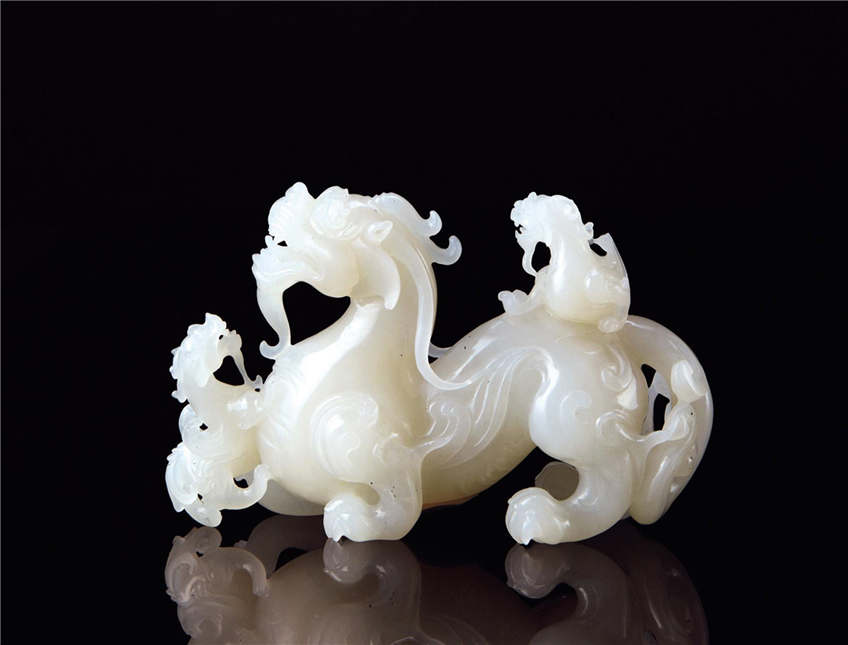Chinese Jade
History of Jade Wares
There is an old Chinese saying "Gold is valuable but jade is invaluable." Dispatching how important and valuable that Chinese people think of this beautiful gem stone with greasy luster. Many countries have jade culture, but no one can catch China with its long and profound jade culture and history.

One of the jade ware that unearthed at Hemudu of Zhejiang province has a history of more than 7,000 years. And 4,000 years ago, at the middle and late Neolithic period, jade articles were more popular, having moved from the use of sacrificial vessels and to an emblem of privilege, buried with high officials in the tomb.
Since spring and autumn period, jade-carving techniques developed quickly and jade pieces were exquisitely carved. Jade ware of this period in patterns of dragon, phoenix were highly treasured today. There was strictly rule for officials on using jade to show different ranks by different patterns. The emperor of Qin Dynasty used jade seal and followed by other emperors. To preserve the body of the dead, Liu Sheng of Han Dynasty, the ruler of the Zhongshan State (113 BC) was buried in the jade burial suit composed of 2,498 pieces of jade, sewn together with gold thread.
In Ming Dynasty, jade ware was not only for decoration-used but have more practical use. Except the personal adornments like jade ring, jade pendant, jade beads from the ancient time, daily articles like jade cup, jade pot and jade bowls were more common. To that time, jade has been classified into 6 categories by their functions, sacrificial vessel, tools, ornaments, utensils and many other items (ancient music instruments made of jade, like jade flute).
From times, there are many masterpieces left along with the change of dynasties. Most Ancient Jade jewelry are treasured collected by collector or exhibited at the museum throughout the world. Some ancient jade pieces are available at Shanghai Museum or Shaanxi History Museum in Xian. Jade has fascinated art lovers worldwide because of both its grandeur and its intimacy, the sheer variety of colors and shapes depicted make it unique as both a subject of as far as well as a subject of the realm of geological formations.

Chinese Jade Culture
As jade have influence walks of life since ancient time, Chinese artisans carved the jade articles in diversified patterns to expressing different meanings influenced by Buddhism or Confucianism thoughts. The most popular pattern were, Buddha - drive off evil sprit, fish - affluence, deer - safety, peach - longevity, bat - blessing, etc.
Some Chinese people also believed that as contained other good ingredients, wearing a jade could do well to body health, balance Yin and Yang and drive of disease, by abstracting some elements.
Jade, also called "Yu" in Chinese, which symbolizes beauty, nobility and purity, were used in many Chinese idioms and phrase to denote beautiful people, their moral and other precious things. "Yu" is also highly taken when parents named their babies, mostly for girls, implying deep blessing for the girls. Confucianism even considered that "an honored man should have virtues of the jade".
There are also some Chinese stories on jades, showing great significance Chinese people paid on jade. One is He Shi Bi (a man called He and his jade), which is a jade named by the man Mr. He. Mr He presented his raw Jade to King again and again, but did not accept and the king though of a totally cheated action and did harm to his body; Mr. He's persistence made the new king touched and finally an invaluable jade appeared. Another story is about the follow up of He Shi Bi, owned by the king of Zhao (475-221 BC). The King of Chu wanted to exchange this jade by giving 15 cities but he failed and the jade was returned to Zhao.

Jadeite & Nephrite
In Chinese, Jade is general classified to two types, soft jade (nephrite) and hard jade (jadeite).
Jadeite refers to Feicui in Chinese, which was introduced to China from early Qing Dynasty (1644-1911) from Burma. It was regarded as the "king of jade" and now more popular and more expensive than soft jade of China.
Nephrite Jade - can be divided into several sub-classifications according to color: white, grey, green, topaz, and black jade. Furthermore, Chinese Nephrite jade could divided to several styles according to their origins, Jade of Hetian in Xinjiang Province, Xiu jade in Liaoning Province, Lantian jade in Shaanxi Province and Nanyang jade in Henan Province.
>> Practical Tips on Buying Jade in China